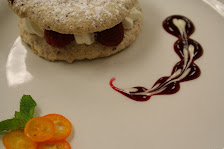Days 70 and 71: “C” is for Cookie…
I never want to see another cookie again. No, really; I might actually mean this. Okay, probably not, but still, I’m a lot closer to saying that truthfully than I’ve ever been before, and I’ve O.D.d on cookies a number of times throughout my history of radically prodigious eating. When our class produced cookies, though, it wasn’t a question of eating a few cookies’ worth of dough from the bowl and then another few ( i.e. several) cookies after baking. Rather, I wandered freely from station to station, tasting each raw dough (a number of times) and then, ultimately, quality-controlling the cookies after baking as well. Allow me to propose a metaphysical excuse for this behavior based on the very nature of why people like cookies to begin with. They’re generally small, and therefore, seeming harmless, it’s conceivable that nearly everyone can enjoy them (if in somewhat more reduced quantities than your host does). Also, since they are so small, you can have a few of them and experience vastly different flavors and textures in the span of one plate; a creamy lemon bar followed by a crunchy almond biscotto (yes, that’s the singular) topped off by a chewy oatmeal... what’s not to love! Not much, I can tell you from my several thorough visits to each station.
Divided into teams of two, we all prepared many dozens of cookies. There are some tricks to making consistently high-quality cookies, but only a few; otherwise making them en masse isn’t very different from making them at home. Here’s a tip for drop cookies (like chocolate chip or oatmeal raisin, say): chill your dough. Seems simple enough, and in some recipes it’s required. For drop cookies, it helps them bake in a much more shapely fashion, since they all go in at the same temperature and consistency and therefore all spread in a similar manner. Given this need to chill, we made our cookies over two days. Some of the cookies were mixed and baked and cooled on day 1, but much of the dough (that which escaped my notice, anyway,) was held over and baked on day 2. After baking the last of them, we took a step back to survey this ocean of cookies we had just created. When over a dozen people have baked several dozen cookies each, what’s required is some serious organizing, the kin to which I have only ever experienced as an observer hovering outside my mother’s kitchen the week(s) before Christmas. Our first step in classifying them was to divide them into two categories: European and American.
The European-style cookies we made included both vanilla and chocolate sablées – sandy straight-ahead cookies which are delightful plain but which are often layered together to make checkerboard cookies; Linzer augen (OW-ghen), which are actually quite good when they haven’t been sitting on a convenience store shelf for several months while their jelly-filling dries out; mamoul, which look like peanut butter cookies but which are in fact filled with a filling of the vastly underappreciated date; Sicilian fig cookies, which are a plain sugary dough wrapped around a rope of fig filling and cut to resemble the letter H or perhaps a pair of chromosomes; macaroons (here the classic French almond-ganache-hamburger style, not the American coconut variety); spritz cookies, like the dry, crumbly cookies with maraschino cherries mashed into the ends of them that every Italian bakery sells by the ton that people pretend to like because they believe them to be fancy; palets aux raisins, amandines, and chocolatines, which are all small, round cookies which are either studded with raisins or made with almond flour or chocolate – tasty, snappy little bites, really; delightfully caky orange- scented madeleines; pignoli (peen-YO-lee), small, Italian shortbread-like cookies studded with pine nuts, tulipes – flat cookies of either vanilla or chocolate which are slightly molded immediately after baking to create a specific shape, such as a small edible dish or a curved cookie; crisp almond biscotti; and Scottish shortbread. All of these cookies were delightful in that they were delicate and refined, many being as rich and satisfying as a much larger dessert.
The American cookies were of a clearly different ilk, including some powerhouse brownies; lemon squares; Tennessee icebox cookies; pecan balls (the dough of which I must confess I ate most unreservedly – if pressed for the truth I would probably admit to perhaps nine cookies’ worth); rugelach, the rolled-up Jewish treat whose sublime flaky dough is made from equal parts flour, butter, and cream cheese (it works, it works well); oatmeal cookies of course, whose chewiness benefited from the inclusion of molasses; pecan sand tarts (like the classic pecan sandy only dressed up to go out); and, of course, that crown jewel of American (and, in your author’s opinion, all) cookies, the chocolate chip. Like their European cohorts, these cookies were all excellent and terribly irresistible, albeit in a less subtle way. The really impressive aspect of the experience, however, wasn’t the taste, but the sheer quantity. The fact that we learned how to execute so very many cookies in a short period of time is significant, as anyone working with me in a bakery sometime in the future will undoubtedly tell you.
To finish the lesson, we divided our thousands of cookies neatly onto trays, as might be served at formal banquets or displayed at fancy bakeries, which we presented for evaluation.
After which I dumped my cookies into a giant box and waddled home.
Sunday, June 3, 2007
Subscribe to:
Comments (Atom)






























































